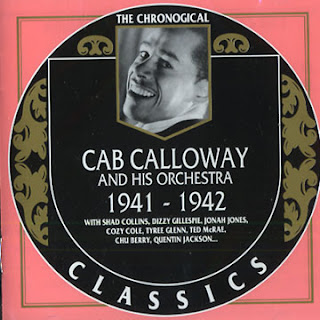The Uncollected Duke Ellington Volume 4 - 1947
This fourth volume of unreleased radio transcriptions by Duke Ellington features eleven performances from January 7 and June 9, 1947. Here are links to volumes one, two, and three. The personnel on the tracks are Shelton Hemphill, Taft Jordan, Wallace Jones, Francis Williams, Ray Nance, and Cat Anderson on trumpets, Lawrence Brown, Claude Jones, and Wilbur DeParis on trombones, Johnny Hodges, Jimmy Hamilton, Russell Procope, Al Sears, and Harry Carney on saxophones, Ellington on piano, Fred guy on guitar, Oscar Pettiford on bass, and Sonny Greer on drums. June 9, Harold Baker and Dud Bascomb replace Wallace Jones and Cat Anderson in the trumpet section. There was a recording ban between January 1 and August 14, 1947, but transcriptions for radio were allowed hence this recording. Furthermore, the time limit of three minutes per song was not required, so there are longer tracks which a couple being longer than five minutes. Many of the tunes her were performed at Carnegie Hall in November 1946. There's a good amount of variety and can be broken down into solo features, extended compositions, and blues songs.
"Flippant Flurry" is a wonderful feature for Jimmy Hamilton on clarinet. Strayhorn's writing is always fresh as this compositions explores different moods. "Sultry Sunset" is yet another beautiful ballad feature for Johnny Hodges on alto saxophone. The writing on these features are wonderful and even though they are not grand scale compositions, the arrangements are exciting with wonderful backgrounds and it's obvious that there was a lot of preparation done for these.
June 9 features E the "W.C. Handy Medley"from the November 1946 Carnegie Hall concerts which the composer himself was present for: "Beale Street Blues", "Memphis Blues", and "St. Louis Blues". Along with "Who Struck Johnny?" (later recorded as "Boogie Bop Blues"), all of the compositions were blues tunes. But the strength lies in the fantastic arrangements by Ellington and Strayhorn that continually develop from start to finish.
The first feature is Ellington's "Golden Cress" and it is through and through a concerto for trombonist Lawrence Brown as he plays through the entire four minute and twenty-five second performance. It is one and half minutes longer than the studio recording from September 1 of that year. It begins as a ballad and Brown is melodiously expressive. He continues improvising over a sudden transition to double-time. After a short section that is out of time, the original tempo comes back for another run through of the melody before a false ending leads to the final coda. Throughout, Brown improvises and displays his mastery of the instrument. It's a wonderful arrangement, but like many of the tunes on this set, was only performed during this period. Brown was in the band until 1955, but perhaps such a challenging arrangement for an underdog instrument was not so popular during Ellington's leaner days.
 |
| 2013 CD cover |
"Jam-A-Ditty" and "Fugue-A-Ditty" are from a group of tunes entitled "The Tonal Group" that was covered in my post on Ellington's 1946 Chicago concerts. These versions are from January 7 and are missing the opener "Mellowditty". Turns out, "Jam-A-Ditty" is subtitled concerto for four horns and features Taft Jordan on trumpet, Lawrence Brown on trombone, Harry Carney on baritone saxophone, and Jimmy Hamilton on clarinet. I previously wrote that they were playing different themes, but on this version it sounds like they're improvising. It culminates with a soli for the four instruments played without accompaniment except for breaks. This is new and creates an exciting performance. "Fugue-A-Ditty" is through composed. Beginning with Hamilton on clarinet playing solo, he is joined by Carney on Bari, and then Claude Jones on trombone. While other sections join in, there is no time being played by the rhythm section and it sounds awfully abstract and similar to Third Stream.
"Happy Go Lucky Local" is played in its entirety here and is considerably stronger than the version from a few months prior. Even though it is fundamentally a blues tune, Ellington's skillful arrangement with textures, transitional sections, and timbres is such that it sounds like a suite with multiple sections. The duet introduction with Pettiford is still here, but this time Ellington explicitly plays the theme that would become known as "Night Train". The tempo is also much slower and it swings very hard. This only heightens the train effects which sound more ironic. The transition section is really the theme, but is only based on one chord and is extended. The finale includes a trading between dissonant piano and bass against the full ensemble. On this track, Pettiford's fills are excellent.
"Overture to a Jam Session" is by Strayhorn and is very much a serious piece of music. I wouldn't say it's impressionistic, but it is definitely not about hummable melodies and dance grooves. A bold piece, there is a section for Nance playing pizzicato and arco.
 |
| W.C. Handy and Duke Ellington Randalls Island, NY, 1938 |
On the entire album, the backgrounds are endlessly creative and exciting and are rarely repeated later in the performance. Behind a string of excellent solos is a subtle symphony of backgrounds filled with ideas that are rapidly expanding. As a result, each song sounds through composed and one easily forgets that the tunes are blues. It's difficult to write an arrangement on someone else's blues, while maintaining one's sound or identity. But the stamp of Ellington is unmistakable where his signature harmonies (diminished/major seven voicings on dominant chords) are present.




Comments
Post a Comment